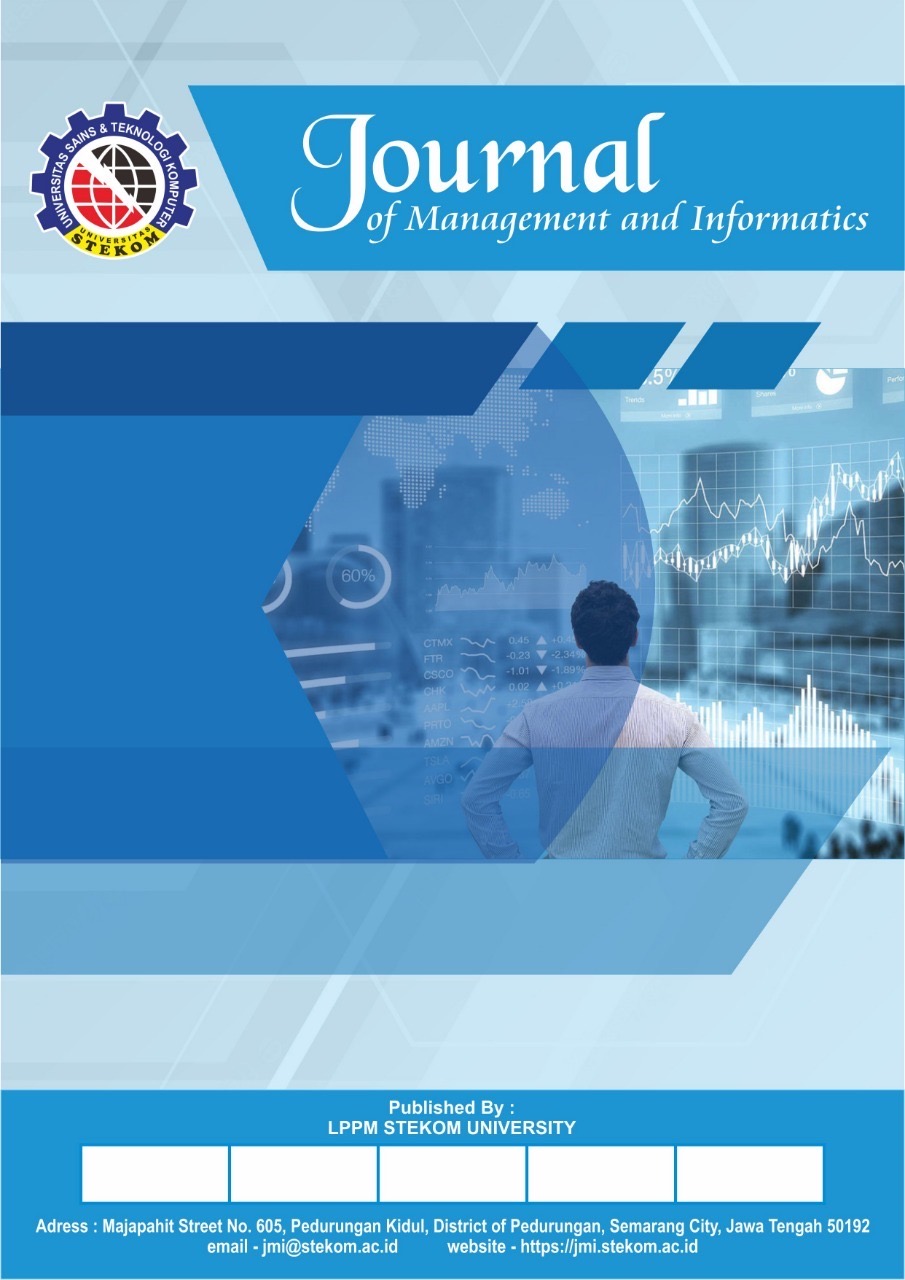The Expert System Application to Diagnose Computer Damage Using UML Model (Unified Modeling Language)
DOI:
https://doi.org/10.51903/jmi.v3i3.52Keywords:
Expert System, UML Modelling, Computer DamageAbstract
The expert system application are developed in line with the existence of information technology. The development of expert systems aims to be a means of assistance to provide solutions in our lives. This expert system can help technicians get solutions quickly and can save time. Expert systems use computer technology to integrate, manipulate and display information or characteristics. Expert systems can also help in making better solutions. With the very rapid technological advances today, an idea or idea has emerged from the author to try to implement one of the expert system application programs into the quality of service activities of computer technicians. The author tries to build an application that will help to facilitate the provision of solutions to computer damage to hardware so that it can make it easier for users or technicians to get solutions quickly. The system to be created is "Designing an Expert System for Diagnosing Computer Problems Using Visual Basic" This system will use the prototype method and tools for modeling using UML (Unified Modeling Language). This system is built using the Visual Basic 6.0 application to process the Microsoft Access database.
References
Ahmed, I. M., Alfonse, M., Aref, M., & Salem, A.-B. M. (2015). Reasoning Techniques for Diabetics Expert Systems. Procedia Computer Science, 65, 813–820. https://doi.org/10.1016/j.procs.2015.09.030
Ahmed, Q., Raza, S. A., & Al‐Anazi, D. M. (2021). Reliability‐based fault analysis models with industrial applications: A systematic literature review. Quality and Reliability Engineering International, 37(4), 1307–1333. https://doi.org/10.1002/qre.2797
Alanazi, M. M. F., Almutairi, Sarah Fahad Mohammed, Alarjani, Norah Owaydhah, Alghaylan, Maisa Yousef A, Aljawhari, Majed Saleh Mohammed, & Alkhulaifi, Abdulrahman Abdullah S. (2024). Advancements in AI-driven diagnostic radiology: Enhancing accuracy and efficiency. International Journal of Health Sciences, 8(S1), 737–749. https://doi.org/10.53730/ijhs.v8nS1.14928
Cholli, N. G., & G. R., A. (2024). Object-Oriented Modelling With Unified Modelling Language 2.0 for Simple Software Application Based on Agile Methodology. SSRN Electronic Journal. https://doi.org/10.2139/ssrn.4936271
Daboor, M., Kharbat, F., Azzuni, F. mueen, Sultan, I., & Odeh, M. (2024). Streamlining CLABSI Diagnosis: An Innovative Process Modeling Approach Using UML Activity Diagrams. 2024 Global Digital Health Knowledge Exchange & Empowerment Conference (GDigiHealth.KEE), 1–6. https://doi.org/10.1109/gDigiHealth.KEE62309.2024.10761600
Dubois, L., & Mack, P. (2024). KNOWLEDGE‐BASED SYSTEMS. In Artificial Intelligence in Process Fault Diagnosis (pp. 300–342). Wiley. https://doi.org/10.1002/9781119825920.ch10
Hendriks, E., Luyten, L., & Parrack, C. (2018). Knowledge exchange and adoption to enable safer post-disaster self-recovery. Journal of Integrated Disaster Risk Management, 8(2), 1–21. https://doi.org/10.5595/idrim.2018.0314
Ivanova, V., Boneva, A., & Vasilev, P. (2024). Unified Modeling Language Application for Laparoscopic Instrument Design. International Journal Bioautomation, 28(3), 117–132. https://doi.org/10.7546/ijba.2024.28.3.000968
Jaboob, A., Durrah, O., & Chakir, A. (2024). Artificial Intelligence: An Overview (pp. 3–22). https://doi.org/10.1007/978-3-031-50300-9_1
Khan, S., & Yairi, T. (2018). A review on the application of deep learning in system health management. Mechanical Systems and Signal Processing, 107, 241–265. https://doi.org/10.1016/j.ymssp.2017.11.024
LUPASC, A. (2021). Use of Unified Modeling Language in the Development of Object-Oriented Information Systems. Annals of Dunarea de Jos University of Galati. Fascicle I. Economics and Applied Informatics, 27(3), 51–56. https://doi.org/10.35219/eai15840409223
Martini, B., Bellisario, D., & Coletti, P. (2024). Human-Centered and Sustainable Artificial Intelligence in Industry 5.0: Challenges and Perspectives. Sustainability, 16(13), 5448. https://doi.org/10.3390/su16135448
Pandey, A., Tiwari, A. K., Nishad, H., & Thomas, S. A. (2025). Innovations in AI and ML for Medical Imaging. In The Impact of Algorithmic Technologies on Healthcare (pp. 127–155). Wiley. https://doi.org/10.1002/9781394305490.ch7
Raihan, A., Arindrajit Paul, Rahman, Md. S., Islam, S., Paul, P., & Karmakar, S. (2024). Artificial Intelligence (AI) for Environmental Sustainability: A Concise Review of Technology Innovations in Energy, Transportation, Biodiversity, and Water Management. Journal of Technology Innovations and Energy, 3(2), 64–73. https://doi.org/10.56556/jtie.v3i2.953
Saibene, A., Assale, M., & Giltri, M. (2021). Expert systems: Definitions, advantages and issues in medical field applications. Expert Systems with Applications, 177, 114900. https://doi.org/10.1016/j.eswa.2021.114900
Sharma, N., & Kaushik, P. (2025). Integration of AI in Healthcare Systems — A Discussion of the Challenges and Opportunities of Integrating AI in Healthcare Systems for Disease Detection and Diagnosis. In AI in Disease Detection (pp. 239–263). Wiley. https://doi.org/10.1002/9781394278695.ch11
Stallman, R. M., & Sussman, G. J. (1977). Forward reasoning and dependency-directed backtracking in a system for computer-aided circuit analysis. Artificial Intelligence, 9(2), 135–196. https://doi.org/10.1016/0004-3702(77)90029-7
Tabachneck-Schijf, H. J. M., & Geenen, P. L. (2009). Preventing knowledge transfer errors: Probabilistic decision support systems through the users’ eyes. International Journal of Approximate Reasoning, 50(3), 461–471. https://doi.org/10.1016/j.ijar.2008.04.010
Thanjavur, N., Bugude, L., & Kim, Y.-J. (2025). Integration of Functional Materials in Photonic and Optoelectronic Technologies for Advanced Medical Diagnostics. Biosensors, 15(1), 38. https://doi.org/10.3390/bios15010038
Xames, M. D., & Topcu, T. G. (2024). A Rapid Review of How Model‐based Systems Engineering is Used in Healthcare Systems. INCOSE International Symposium, 34(1), 1447–1462. https://doi.org/10.1002/iis2.13218
Yang, X., & Zhu, C. (2024). Industrial Expert Systems Review: A Comprehensive Analysis of Typical Applications. IEEE Access, 12, 88558–88584. https://doi.org/10.1109/ACCESS.2024.3419047
Downloads
Published
Issue
Section
License
Copyright (c) 2024 Journal of Management and Informatics

This work is licensed under a Creative Commons Attribution-ShareAlike 4.0 International License.


